A few weeks ago I took a day off work to ride much of the way across my newly adopted home region of Wallonia – the French speaking bit of Belgium. I was headed south to Huy to watch the Fleche Wallonne cycle race (post here) but what I also wanted was to stretch my cycling boundaries and explore. And in doing so I was able to unravel a previous confusion about the cycling landscape and prove to myself that cycling in Wallonia is indeed upside down.
I also found brilliant riding. I don’t think I have never met anyone who has told me about touring round Belgium so I had no idea what to expect when I came here. A few people had done trips to the WW1 battlefields over in Flanders and I know the odd person who has made the pilgrimage to the big bike races but I just don’t recall “cycle touring in Belgium” being a common discussion point amongst my UK cycling community.
People seeking flat and cyclist friendly riding go to the Netherlands. And to our south France is the biggest cycle touring market in Europe, possibly the world. But as in so many other things dear Belgium gets, well a little bit lost.
On this particular day I experienced two, maybe three very distinctive landscapes which in their own right would provide part of a brilliant tour, both of which show off some of the distinctive elements of Wallonia. It isn’t perfect, cyclists don’t get anywhere near as much help with routes as in Flanders, the Netherlands or France and some of the road surfaces are abominable, but there is no reason for southern Belgium not to be a great cycle touring destination.
Above all else it is completely deserted. Again I have say it, come here fellow cyclists, it is so quiet. A normal Wednesday, a weekday when people are going about their business, the commuter routes into Brussels were as congested as ever and yet I rode for hours and hours on apparently empty roads, hardly seeing a car except when I crossed busier main roads. 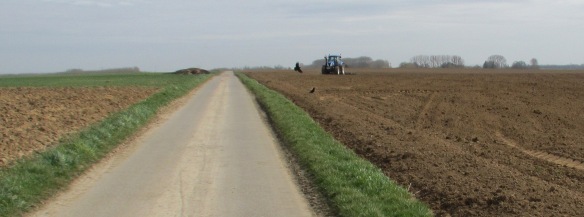
Farmers were busy, but apparently nobody else.
And there is a tolerance for cyclists that far exceeds any experience I have had in the UK, and is a complete contrast to Brussels. Maybe it is the lycra, as if lby ooking like a sporty cyclist you seem to spark a certain recognition in the Walloons, but whatever it is I love being treated like a valuable property not an inconvenience.
Upside down country?
I knew that I was heading for the hilly bit of Belgium. Not massive climbs but clearly from descriptions of the Ardennes and the profiles of the bike races it was going to be an area of steep sided hills. Not so different from Brabant Wallon where I live, but probably steeper and bigger. As I like hilly country for cycling I was looking forward to it.
But what I didn’t know much about was the terrain in between, a 50-60km section between the main towns of Wavre and Namur. My previous excursions had touched on flatter terrain and open farmland, but the maps didn’t show any transition to the Ardennes which was a bit odd, I assumed it must start to climb somewhere.
That was almost how it turned out. I had half a ride on gently rolling but exposed farmland. And then I hit the valleys at the very edge of the Ardennes and I was suddenly plunged into steep sided gorges with rock walls and dark stone cottages that could have been plucked out of the English Peak District or the French Perigord Nord.
But the key to understanding the Walloon landscape revealed itself to me as I made that transition. I hit valleys, not hills.
When that realisation dawned suddenly I could make sense of a whole lot of landscapes, not only on that day, but around where I live south of Brussels. I appear to have got this whole region upside down.
I haven’t studied the geology in a text book, so go with me here, it might make sense to a cyclist.
Through Northern France and into Belgium is a wide coastal plan that gradually rises as it heads inland. There are ripples and lumps and bumps, but this is largely flat country. Further north in the “Low Countries” it stays close to sea level however further inland from the coast this plain rises to 100, maybe 150 metres above sea level. In the East in what is now the Ardennes the plain must have been pushed up by geological forces higher and forms a plateau around 700 metres high, but still these are not really mountains thrust up into the landscape, it’s geology was pretty flat when it was laid down.
So there should be no real hills.
Except that there are rivers, which have cut downwards into the soft soils and rocks over thousands of years. So instead of ups, there are downs. Instead of peaks we have flats, when you complete a big climb you end up back on the flat land. It is like the reverse of everywhere I have ever cycled, when you come off a flat section you go down, then you climb back up. That is a right pain if you feel like a bit of freewheeling after a long hill climb!
Where I live in there are many small rivers like La Lasne, Smohain, l’Argentine and La Mazerine, each of which has carved out one of our steep valleys 50-70 metres deep. This makes it feel like constant climbing if you have to travel north to south as I do every time I ride to Brussels.
On my cycle tour across Wallonia I started with a few of these dips and climbs of Brabant Wallon however I was quickly into the an area without significant streams or rivers, so when I climbed out of the last valley to Mont St Guibert there was nearly 50km of gently rolling flat farmland in front of me which will appeal to any lover of cycle tourism on tiny agricultural roads between old farms and sleepy historic villages. Think the Netherlands, think East Anglia, think the Vendee depending on your previous cycling experiences. Dramatic it isn’t, delightful it is. 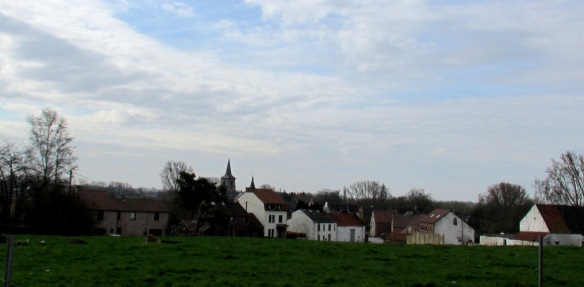 The little towns and villages like Chastre, Walhain, Grand Leez, Waret-la-Chausée just slipped by with the spires of their churches and manor houses making attractive punctuation points on the horizon.
The little towns and villages like Chastre, Walhain, Grand Leez, Waret-la-Chausée just slipped by with the spires of their churches and manor houses making attractive punctuation points on the horizon. 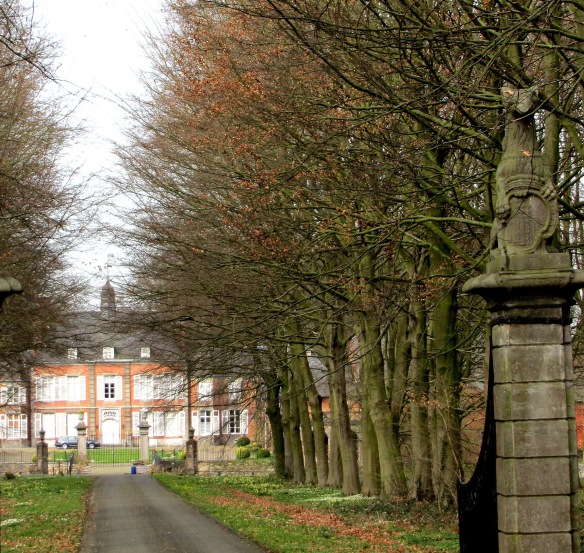
However it is pretty exposed and a nagging headwind really took the edge of my pace, I would really rather have had some variety at times.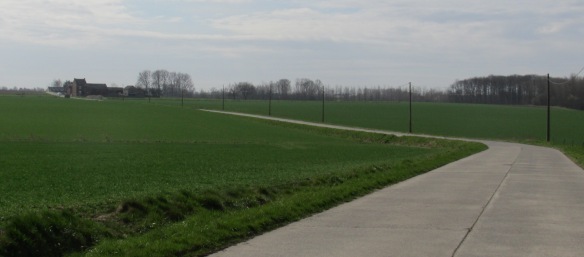
I only really understood how this fitted together with the Ardennes this when I reached the valley of the Meuse just east of Namur and a great vista opened out in front of me. But instead of looking up as I had expected to the forthcoming hills I looked across?
Ahead of me the plain could have continued climbing gently and eventually reach the 600 metres of Belgium’s highest point. But it was deeply cut by the many rivers and streams feeding into the Meuse and what I could see from my vantage point was not a series of hills but a tumbling mass of valleys.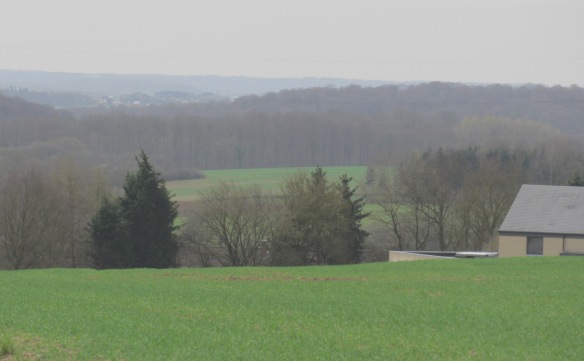
The hills of the Ardennes are hills of sorts, but their main shape comes from crossing the valleys, not climbing hills. They do end up a lot bigger than around Brussels because the plain has been rising all the way so the valleys can cut deeper over time, but the much of the landscape is still just open and flat, just that it is 200-300 metres above sea level. This became even clearer when later in my ride I kept climbing out of the valleys and discovering more wide open farming land at the top instead of the peaks of hills I had expected. But the depth of the valleys makes them like another place. The houses are built of stone not brick, the sides are heavily wooded and the villages are just cute as anything, especially as spring blossom was just appearing.
The exception to the cuteness was the valley of the Meuse which forms the boundary of this new area. Initially I dropped very fast and steeply down a lovely side valley alongside a stream, passing mills and cottages in dark stone which reminded immediately of the English Peak District.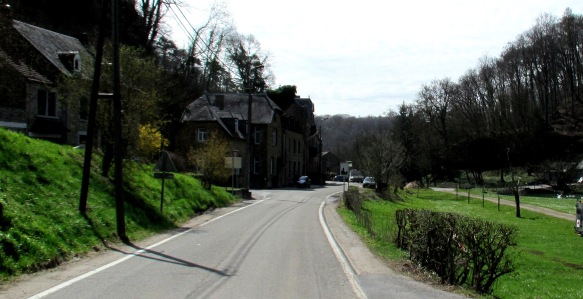
At the end it was almost a shock to burst out onto the side of the Meuse. This is a big river, one of the workhorses of Europe and it suffers from its heritage as an industrial canal with big cement works, railways, boat moorings, main roads and a railway line all exploiting its history as transport corridor, especially on the northern bank where the main towns in this section are. The south bank looked a lot pleasanter thank goodness..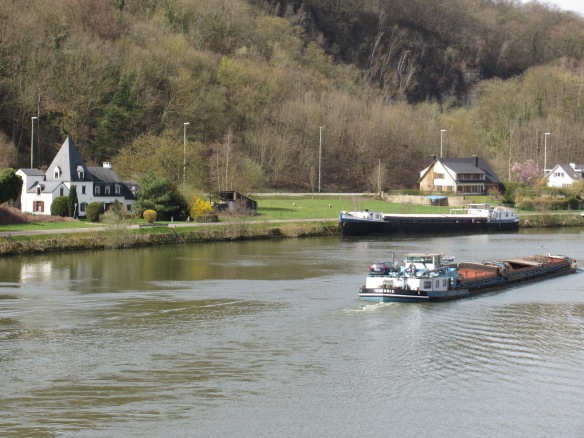
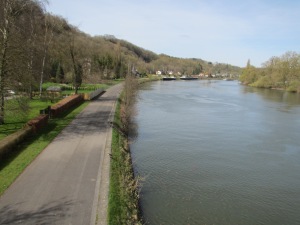 I only rode a few kilometres along the only busy road of my day until I could get to the first bridge and across into the quiet countryside again. However I had noticed on the maps that there is a Meuse cycle route and when I rode over the bridge at I could see a flat riverside path winding away into the distance which clearly was the sort of long distance car free route that crosses Europe by the great rivers. So even a third sort of cycle touring was on offer had I wanted just to nip along the river to Huy on flat car free trails.
I only rode a few kilometres along the only busy road of my day until I could get to the first bridge and across into the quiet countryside again. However I had noticed on the maps that there is a Meuse cycle route and when I rode over the bridge at I could see a flat riverside path winding away into the distance which clearly was the sort of long distance car free route that crosses Europe by the great rivers. So even a third sort of cycle touring was on offer had I wanted just to nip along the river to Huy on flat car free trails.
But I had come for the Ardennes, or at least the edge of the Ardennes, so I had planned a further30km route south of the Meuse and the route of Fleche Wallonne, circling round and come back to Huy from the south, arriving at the top of the Muy de Huy with about 100km under my wheels. I had expected constant climbing and descending but the reality was quite different.
As with the earlier section of the ride I was quickly into a network of minor roads with hardly any traffic on them. South from Namèche I was able to wind my way gradually up a lovely valley past Faulx les Tombes for several kilometres.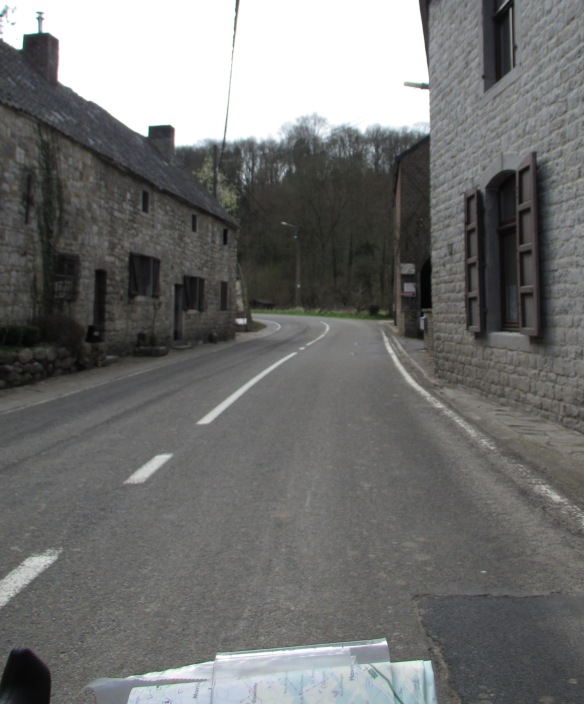
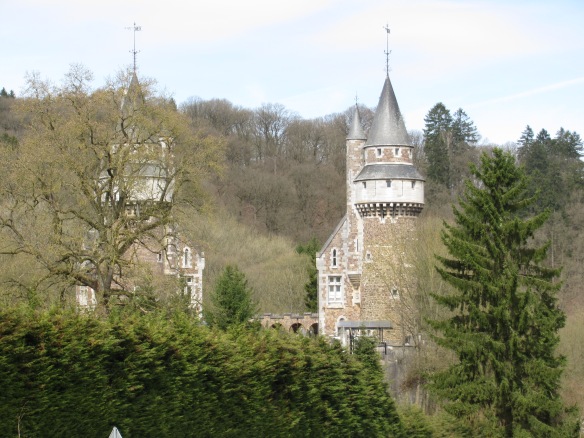
I didn’t gain much height but then I turned east and climbed fairly vigorously up Gesves which it turns out is very much a plateau town, looking across high open farmland. I was getting pretty tired at this point and as I was at the top of one of my main climbs of the day I really rather hoped for a nice sweeping decent.
In fact I then had another flattish ride of about 15km northeast on plateau landscape, not what I had expected at all. However I was rewarded when I approached Modave because there was a great decent down and I made my first encounter with the Fleche Wallonne route. A relatively short steep climb out the other side took me back onto the plateau and I was finally working my way in towards Huy. Once again it was deceptive, I appeared to be riding towards a village on a low hill above the farmland. When I encountered the race publicity caravan just south of Huy it seems impossible to imagine they had just come up one of the most famous climbs in cycle racing.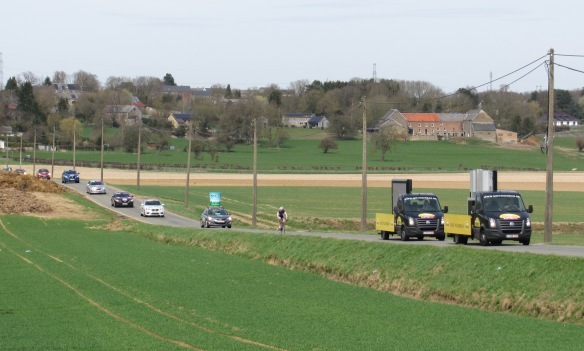
Only when I got to the very top of Mur de Huy could I see that the road effectively “fell off a cliff” falling steeply down through the suburbs and then at the bottom the town is a bustling place by the Meuse. You can get a good impression of the Mur de Huy from here just by looking up at the hill behind the town.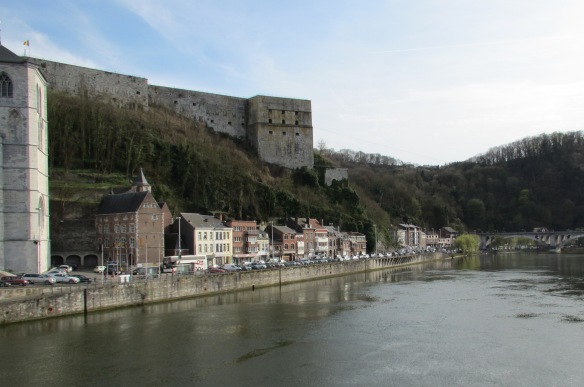
The distinction between the plateau and the valleys is so contrasting it is almost like two worlds, even the architecture and the building materials are different between high and low, as are the farming patterns and woodlands.
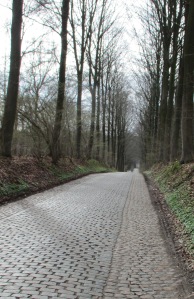 Those low traffic volumes, driver respect and contrasting terrains should make Wallonia one of cycle touring’s undiscovered gems instead of something just for the Belgians and a few bike race fans. Maybe it suffers from the fact that it does offer “a bit of everything” because someone describing just one part of my ride on this sunny spring day would had told a completely different story to the next person. The downside is certainly that it isn’t easy to navigate, the theoretical Randonnee á Velo shown on some of my maps have no signposting whatsoever so you need to be confident with a map and reasonably well organised to decide if you wanted to stick to a hilly scenic ride or a meander through the lanes. And
Those low traffic volumes, driver respect and contrasting terrains should make Wallonia one of cycle touring’s undiscovered gems instead of something just for the Belgians and a few bike race fans. Maybe it suffers from the fact that it does offer “a bit of everything” because someone describing just one part of my ride on this sunny spring day would had told a completely different story to the next person. The downside is certainly that it isn’t easy to navigate, the theoretical Randonnee á Velo shown on some of my maps have no signposting whatsoever so you need to be confident with a map and reasonably well organised to decide if you wanted to stick to a hilly scenic ride or a meander through the lanes. And 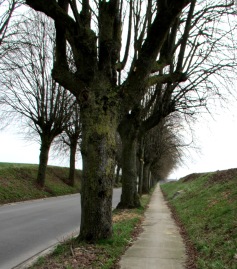 the Belgians have an extremely relaxed attitude to what constitutes a road for cyclists, in some cases we are talking almost cart track. However that is always preferable to a kilometre of cobbles, that really does knock back your energy and your speed, however it is so much part of the infrastructure there is just no way of knowing until you get there what you are going to be offered. Cycle lanes are almost redundant except by the main roads but they were generally reasonable quality and occasionally real gems.
the Belgians have an extremely relaxed attitude to what constitutes a road for cyclists, in some cases we are talking almost cart track. However that is always preferable to a kilometre of cobbles, that really does knock back your energy and your speed, however it is so much part of the infrastructure there is just no way of knowing until you get there what you are going to be offered. Cycle lanes are almost redundant except by the main roads but they were generally reasonable quality and occasionally real gems.
All in all a brilliant day’s exploration, topped off with beer, frites and bike racing. It doesn’t get much better than that does it? Do come a visit Wallonia, there is something for every sort of cyclist here, even if it is upside down.

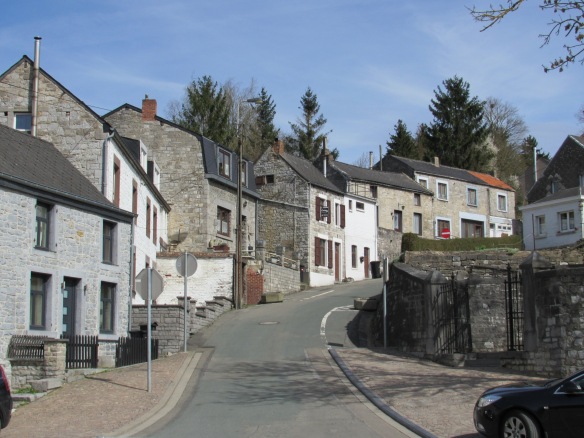
I think you are spot on about the fact that the Ardennes is a series of valleys instead of hills even though my knee may beg to differ. As a result, the descents and the ascents tend to come almost as a surprise, which in some sense makes it more challenging to ride because, unless you are familiar with the route, it does not allow you to anticipate. It’s certainly not like in the French Alps where you see your next giant climb from 15 km away, and you get to have an ‘oh shit’ moment well before the climb actually starts. And, of course, as you say, in the Ardennes there is usually no reward of a freewheeling descent right after a climb. The consolation is that the climbs tend to be short, 2 or 3 km max, even if some may be devilishly steep.
I also agree that the region is undersold as a cycling destination. But then, the Walloons are not very good at selling anything. Some of the worst web sites and leaflets in the world are Walloon, particularly those related to cycling. Truly painful stuff. Their dreadful marketing skills aside, the region, as you say, is a bit difficult to package to attract foreigners because it is not obvious what the headline attributes are: it’s more a generalist than a specialist.
LikeLike
I’m glad my babbling made sense to someone, you are way ahead of me with your experience of all these things Belgian and cycling.
I’d rather not be rude about my Walloon neighbours just yet, although as the blog isn’t in French nobody will notice. Let’s call them “understated”?
LikeLike